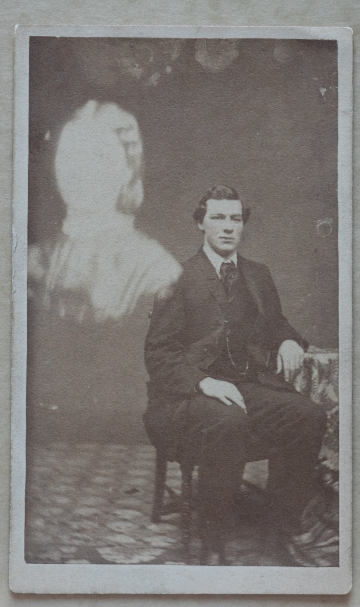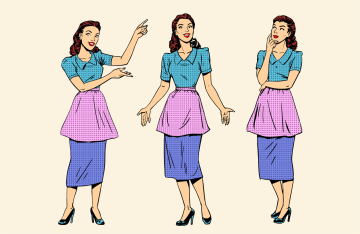A New Exhibit at Annenberg Explores Philadelphia’s History of Communicating With Ghosts
The exhibit from the Annenberg Extended Reality Lab explores the 19th-century religious movement Spiritualism.

A visitor uses a VR headset (Photo: Anna Gamarnik)
In 1874, at a second-floor parlor on 50 North Ninth Street in Philadelphia, two mediums, Jennie Holmes and her husband, Nelson Holmes, electrified audiences by claiming they could fully materialize a ghost called Katie King. Unlike flickering lights or cryptic knocks, Katie King appeared completely: a pale young woman said to be 400 years old. For eight months, she captivated visitors ranging from curiosity seekers to leading politicians, such as Robert Dale Owen, who chronicled his encounters with King in a widely read essay in the Atlantic Monthly.

Newspapers buzzed with reports of the séances, and the Holmes’ parlor became a pilgrimage site for the spiritually curious. However, the illusion unraveled spectacularly when a skeptic grabbed the supposed spirit, revealing her as a local actress named Eliza White. White’s public confession, published in the Philadelphia Inquirer, described how she impersonated Katie King and how the Holmeses orchestrated the deception. The revelation was a sensation, sparking international headlines and plunging the newly popular Spiritualist movement, whose proponents believed that departed souls could speak to the living through mediums, into crisis.
This case is at the center of a new exhibit at the Annenberg School for Communication — "Degrees of Dis/embodiment: Communication Across Planes of Existence." The exhibit explores the Spiritualism movement, its roots in Philadelphia, at the University of Pennsylvania, and humanity’s persistent fascination with contacting unseen worlds, whether through séances or virtual reality headsets.
“After hearing about Katie King, Eliza White, and her book-length confession explaining how the tricks were done, we began to realize that many of these technologies used by the mediums in the 19th century are similar to the technologies used in XR today," Kyle Cassidy, co-director of the Annenberg Extended Reality Lab, says.
This exhibition is a collaboration between Annenberg doctoral students Arelí Rocha and Sara Reinis and Lab Co-Directors Katerina Girginova and Cassidy. The team wrote about the research behind the exhibit in a recent ASAP/Review paper.
Spiritualism in Philadelphia

In the mid-19th century, as the United States reeled from the devastation of the Civil War, Spiritualism offered a balm to this loss: a way to communicate with lost loved ones. During Spiritualists’ séances, popular mediums conjured messages from ghosts, offering both consolation and spectacle to visitors hoping to connect with the dead.
Rocha, who studies human relationships with artificial intelligence, including AI companion chatbots, finds this 19th-century obsession with connecting with the dead similar to her research. She became involved with the exhibit after talking to Cassidy about Katie King.
"Kyle told me about the Philadelphia ghost who received mementos from people who grew quite attached to her and there were parallels with my research in terms of forming relationships with the nonhuman," she says.
Through archival photographs, newspaper clippings, explanatory text, and multimedia experiences, “Degrees of Dis/embodiment” shows how the drive to communicate beyond ordinary limits thrived in the 19th century and continues today.
Spiritualism and Penn
Much of the exhibit concerns a request by Henry Seybert, a wealthy Philadelphian, to have the University of Pennsylvania investigate Spiritualism. After his death, he left a $60,000 bequest to the University. The first part of the gift established the Adam Seybert Professor in Moral and Intellectual Philosophy, an endowed chair named after Seybert’s father that still exists today. The second came with the condition that the University appoint a special commission to investigate "all systems of Morals, Religion, or Philosophy which assume to represent the Truth," with a special emphasis on Spiritualism.

The “Seybert Commission for Investigating Modern Spiritualism” was established in 1884, and a group of faculty members from Penn spent three years investigating the methods of popular Spiritualist mediums. Investigation activities included hosting séances and inspecting the means that mediums used to speak to the dead, which included asking spirits to knock on tables, write on slate tablets, move physical items, or answer letters.
The commission’s verdict was that the demonstrations were all “trickery” and “fraud,” and no further reports were made.
“Degrees of Dis/embodiment” reminds us that the drive to communicate beyond ordinary limits is not confined to any single era.
"Today, educational institutions like the University of Pennsylvania are again at the forefront of championing the seemingly unworldly, including XR and AI research," Girginova told the crowd at the exhibit's opening.



